#Employee Database Management Software
Explore tagged Tumblr posts
Text
Essential Things You Need to Know About Staff Management Software in 2023
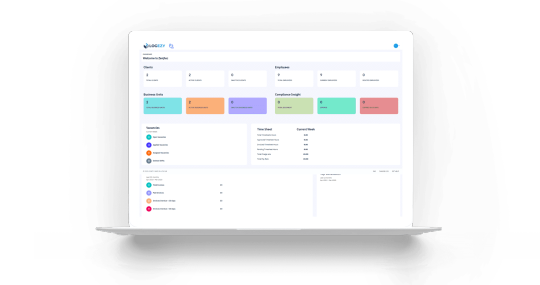
In today's fast-paced digital era, the significance of effective staff management cannot be overstated. Staff management software has quickly become an integral part of efficient business operations in various industries. With the continuous evolution of technology, 2023 has brought forth new updates, features, and trends to watch out for. Here's what you need to know about staff management software this year.
Remote Work Adaptability:
With the increase in remote work due to the ongoing pandemic, staff management software now offers features that adapt to this new work model. Tools for virtual meetings, remote project management, and digital timesheets have become standard.
Employee Wellbeing and Engagement:
Employee mental health has gained more focus. In 2023, staff management software increasingly includes features promoting employee wellbeing, such as mood tracking, mental health resources, and wellness programs. Simultaneously, gamification strategies are being utilized to improve employee engagement and satisfaction.
Security and Data Privacy:
As we handle more sensitive data digitally, the importance of cybersecurity has skyrocketed. In 2023, staff management software has stepped up its game with enhanced data encryption, multi-factor authentication, and regular software updates to ward off potential cybersecurity threats.
Integration and Customization:
Integration with other systems such as CRM, payroll, and HRIS is more seamless than ever. Furthermore, staff management software now offers greater customization options to cater to the unique needs of each organization.
Eco-Friendly Practices:
More businesses are looking for ways to reduce their carbon footprint. Paperless management, energy-efficient operations, and other eco-friendly features are more common in staff management software in 2023.
Conclusion:
Staff management software in 2023 is about more than just efficiency and productivity; it's about creating a conducive and sustainable work environment that values employees' mental health and respects data privacy. As technology evolves, we can expect these systems to become even more intelligent, versatile, and user-friendly, becoming an indispensable tool in the modern workplace.
#staff management software#employee work management system#staff management system#employee management system#employee payroll management system#employee database management software#best staff management software#temporary staff management software#temporary staffing uk#medical staffing solutions timesheet#employee management software
1 note
·
View note
Text
Streamlining Efficiency: The Significance of Employee Database Management Systems
In the contemporary workplace, the efficient management of employee data stands as a pivotal factor in organizational success. As businesses continue to evolve, so too does the complexity of handling employee information. This is where Employee Database Management Systems (EDMS) emerge as indispensable tools, offering streamlined solutions for organizing, accessing, and securing vital employee data.
Understanding Employee Database Management Systems
Employee Database Management Systems, often referred to as Human Resource Information Systems (HRIS) or Human Resource Management Systems (HRMS), are comprehensive software solutions designed to centralize and streamline the management of employee-related information within an organization. These systems encompass a wide array of functionalities, ranging from basic record-keeping to advanced analytics and reporting capabilities.

The Importance of Employee Database Management Systems
Efficiency Enhancement: One of the primary benefits of an EDMS is its ability to enhance operational efficiency within an organization. By centralizing all employee data into a single, accessible platform, HR professionals can easily retrieve, update, and manage information without the need for manual paperwork or spreadsheets.
Data Accuracy: Manual data management processes are prone to errors, leading to discrepancies in employee records. EDMS eliminates this risk by enforcing data consistency and accuracy through standardized input formats and validation checks. This ensures that crucial information such as employee demographics, payroll details, and performance evaluations remain reliable and up-to-date.
Compliance and Security: In an era marked by stringent data protection regulations, maintaining compliance with legal requirements is paramount. EDMS offers robust security features, including role-based access controls, encryption, and audit trails, to safeguard sensitive employee information from unauthorized access or breaches. By adhering to regulatory standards such as GDPR or HIPAA, organizations can mitigate legal risks and protect the privacy rights of their employees.
Strategic Decision-Making: The insights derived from EDMS analytics empower organizational leaders to make informed, data-driven decisions regarding workforce management, talent acquisition, and resource allocation. By analyzing trends in employee performance, turnover rates, and training needs, HR professionals can devise strategies to optimize workforce productivity and drive business growth.
Employee Empowerment: Self-service functionalities integrated into EDMS empower employees to manage their personal information, request time off, or access relevant documents autonomously. This not only fosters a culture of transparency and accountability but also reduces the administrative burden on HR staff, allowing them to focus on more strategic initiatives.
Key Features of Employee Database Management Systems
Centralized Data Repository: EDMS consolidates all employee-related information, including personal details, employment history, benefits enrollment, and performance evaluations, into a centralized database accessible to authorized users.
Automated Workflows: From onboarding new hires to processing payroll and conducting performance appraisals, EDMS automates routine HR processes, eliminating manual tasks and minimizing the risk of errors or delays.
Customizable Reporting: EDMS offers customizable reporting capabilities, allowing organizations to generate tailored reports on key HR metrics, compliance status, and workforce analytics to support decision-making at various organizational levels.
Integration Capabilities: Seamless integration with other enterprise systems such as payroll software, time and attendance systems, and applicant tracking systems enhances data consistency and eliminates redundant data entry tasks.
Scalability: As organizations grow and evolve, EDMS provides scalability to accommodate changing workforce dynamics, whether through organic expansion, mergers, or acquisitions, ensuring that HR processes remain agile and adaptable to evolving business needs.
Upon deployment, the EDMS streamlined various HR processes, including recruitment, onboarding, performance management, and benefits administration. With centralized access to real-time employee data, HR managers could make informed decisions regarding talent management and resource allocation, resulting in improved workforce productivity and employee satisfaction.
Moreover, the robust security features of the EDMS ensured compliance with data protection regulations, mitigating the risk of data breaches and legal penalties. Through customizable reporting functionalities, organizational leaders gained actionable insights into key HR metrics, facilitating strategic planning and resource optimization.
Conclusion
Employee Database Management Systems represent a cornerstone of modern HR practices, offering organizations the tools needed to streamline processes, ensure data accuracy, and drive strategic decision-making. By harnessing the power of EDMS, businesses can unlock efficiencies, enhance compliance, and empower their workforce, laying the foundation for sustainable growth and organizational excellence. As technology continues to advance, the role of EDMS in shaping the future of work will only become more pronounced, making it essential for businesses to invest in robust solutions that align with their strategic objectives and empower their most valuable asset – their employees. Learn more
#Employee Database Management Systems#erp solutions for schools#erp solutions for educational institutions#admission management software#erp software for Educational institutes#erp software for Education
0 notes
Text
Employee Database Management System: Enhancing Efficiency and Organizational Productivity
Introduction:
In today's dynamic business environment, the effective management of human resources is critical for the success and sustainability of any organization. Employee Database Management Systems (EDMS) play a pivotal role in streamlining HR processes, enhancing data accuracy, and promoting overall organizational efficiency. This article delves into the significance of EDMS, its key features, benefits, challenges, and best practices for implementation.

I. Importance of Employee Database Management Systems:
Centralized Data Repository: An EDMS serves as a centralized repository for all employee-related information. This includes personal details, employment history, training records, performance evaluations, and more. This consolidation eliminates the need for disparate systems, reducing the chances of data redundancy and ensuring data integrity.
Efficient Data Retrieval: With a well-structured EDMS, HR professionals can swiftly retrieve relevant information. This not only saves time but also enhances decision-making processes, such as promotions, talent acquisition, and performance appraisals.
Compliance and Security: Employee data is often sensitive and subject to various regulations. An EDMS helps organizations adhere to data protection laws by implementing robust security measures. This ensures that confidential information is accessed only by authorized personnel, mitigating the risk of data breaches.
II. Key Features of Employee Database Management Systems:
User-Friendly Interface: A successful EDMS incorporates a user-friendly interface, making it easy for HR professionals and administrators to navigate and manage the system efficiently. Intuitive design reduces the learning curve and promotes widespread adoption within the organization.
Customizable Access Levels: EDMS should offer customizable access levels, allowing organizations to define who can view, edit, or delete specific information. This feature is crucial for maintaining data security and ensuring that only authorized personnel can access sensitive data.
Integration with Other HR Modules: To maximize efficiency, EDMS should seamlessly integrate with other HR modules, such as payroll, performance management, and recruitment. This integration facilitates a holistic view of employee information and ensures a cohesive HR ecosystem.
Automated Workflows: Automation is a key aspect of modern EDMS. Automated workflows streamline routine HR processes, such as onboarding, leave approvals, and performance reviews. This not only reduces manual workload but also minimizes the risk of errors.
III. Benefits of Employee Database Management Systems:
Increased Efficiency and Productivity: EDMS streamlines HR processes, eliminating manual paperwork and reducing the time spent on administrative tasks. This efficiency boost allows HR professionals to focus on strategic initiatives, contributing to overall organizational productivity.
Accurate and Timely Reporting: The centralized nature of EDMS ensures the accuracy of employee data. This, in turn, facilitates the generation of timely and accurate reports, enabling data-driven decision-making by management.
Enhanced Employee Experience: An efficient EDMS contributes to a positive employee experience by ensuring that HR services are delivered promptly and accurately. Employees can access and update their information easily, fostering a sense of control and engagement.
Improved Compliance and Risk Management: Compliance with data protection laws and regulations is a critical aspect of HR management. EDMS helps organizations stay compliant by implementing robust security measures and providing audit trails, reducing the risk of legal issues and financial penalties.
IV. Challenges in Implementing Employee Database Management Systems:
Resistance to Change: Employees may resist transitioning from traditional methods to an EDMS due to a fear of change. Addressing this resistance requires effective communication, training programs, and showcasing the benefits of the new system.
Data Migration Issues: Migrating existing employee data to a new system can be challenging. Ensuring data accuracy and completeness during the migration
process is crucial. Organizations need to invest time and resources in thorough planning and testing to mitigate potential data migration issues.
Integration Challenges: Integrating EDMS with existing HR modules or other enterprise systems may present challenges. Compatibility issues, data mapping, and system synchronization need careful consideration during the implementation process.
Cost and Resource Allocation: Implementing an EDMS requires a significant investment in terms of technology, training, and human resources. Organizations need to carefully assess their budget constraints and allocate resources effectively to ensure a successful implementation.
V. Best Practices for Implementing Employee Database Management Systems:
Needs Assessment: Before implementing an EDMS, conduct a comprehensive needs assessment to understand the specific requirements of your organization. Identify key features and functionalities that align with your HR processes and goals.
User Training and Support: Invest in comprehensive training programs to familiarize users with the new EDMS. Provide ongoing support to address any issues or questions that may arise during the transition period, ensuring a smooth adoption process.
Data Security Measures: Prioritize data security by implementing robust encryption, access controls, and authentication mechanisms. Regularly update security protocols to stay ahead of emerging threats and protect sensitive employee information.
Pilot Testing: Conduct pilot testing with a small group of users before rolling out the EDMS across the entire organization. This allows for identification and resolution of any potential issues, ensuring a more successful and seamless implementation.
Regular System Audits: Perform regular audits of the EDMS to ensure data accuracy, integrity, and compliance. Regularly update the system to incorporate new features, security patches, and improvements to keep it aligned with evolving organizational needs.
Conclusion:
In conclusion, Employee Database Management Systems are indispensable tools for modern organizations seeking to optimize their human resources management processes. By centralizing employee information, streamlining workflows, and enhancing data security, EDMS contribute significantly to increased efficiency, productivity, and overall organizational success. However, successful implementation requires careful planning, consideration of challenges, and adherence to best practices. With the right approach, an effective EDMS can serve as a cornerstone in fostering a positive work environment and driving organizational growth.
0 notes
Text
The Trump administration, working in coordination with Elon Musk’s so-called Department of Government Efficiency, has gutted a small federal agency that provides funding to libraries and museums nationwide. In communities across the US, the cuts threaten student field trips, classes for seniors, and access to popular digital services, such as the ebook app Libby.
On Monday, managers at the Institute of Museum and Library Services (IMLS) informed 77 employees—virtually the agency’s entire staff—that they were immediately being put on paid administrative leave, according to one of the workers, who sought anonymity out of fear of retaliation from Trump officials. Several other sources confirmed the move, which came after President Donald Trump appointed Keith Sonderling, the deputy secretary of labor, as the acting director of IMLS less than two weeks ago.
A representative for the American Federation of Government Employee Local 3403, a union that represents about 40 IMLS staffers, said Sonderling and a group of DOGE staffers met with IMLS leadership late last month. Afterwards, Sonderling sent an email to staff “emphasizing the importance of libraries and museums in cultivating the next generation’s perception of American exceptionalism and patriotism,” the union representative said in a statement to WIRED.
IMLS employees who showed up to work at the agency on Monday were asked to turn in their computers and lost access to their government email addresses before being ordered to head home for the day, the employee says. It’s unclear when, or if, staffers will ever return to work. “It’s heartbreaking on many levels,” the employee adds.
The White House and the Institute of Museum and Library Services did not immediately respond to requests for comment from WIRED.
The annual budget of IMLS amounts to less than $1 per person in the US. Overall, the agency awarded over $269.5 million to library and museum systems last year, according to its grants database. Much of that money is paid out as reimbursements over time, the current IMLS employee says, but now there is no one around to cut checks for funds that have already been allocated.
“The status of previously awarded grants is unclear. Without staff to administer the programs, it is likely that most grants will be terminated,” the American Federation of Government Employee Local 3403 union said in a statement.
About 65 percent of the funding had been allocated to different states, with each one scheduled to receive a minimum of roughly $1.2 million. Recipients can use the money for statewide initiatives or pass it on to local museum and library institutions for expenses such as staff training and back-office software. California and Texas have received the highest allocated funding, at about $12.5 million and $15.7 million, respectively, according to IMLS data. Individual libraries and museums also receive grants directly from IMLS for specific projects.
An art museum in Idaho expected to put $10,350 toward supporting student field trips, according to the IMLS grant database. A North Carolina museum was allotted $23,500 for weaving and fiber art workshops for seniors. And an indigenous community in California expected to put $10,000 toward purchasing books and electronic resources.
In past years, other Native American tribes have received IMLS grants to purchase access to apps such as Hoopla and Libby, which provide free ebooks and audiobooks to library patrons. Some funding from the IMLS also goes to academic projects, such as using virtual reality to preserve Native American cultural archives or studying how AI chatbots could improve access to university research.
Steve Potash, founder and CEO of OverDrive, which develops Libby, says the company has been lobbying Congress and state legislatures for library funding. “What we are consistently hearing is that there is no data or evidence suggesting that federal funds allocated through the IMLS are being misused,” Potash tells WIRED. “In fact, these funds are essential for delivering vital services, often to the most underserved and vulnerable populations.”
Anthony Chow, director of the School of Information at San José State University in California and president-elect of the state library association, tells WIRED that Monday was the deadline to submit receipts for several Native American libraries he says he’d been supporting in their purchase of nearly 54,000 children’s books using IMLS funds. Five tribes, according to Chow, could lose out on a total of about $189,000 in reimbursements. “There is no contingency,” Chow says. “I don’t think any one of us ever thought we would get to this point.”
Managers at IMLS informed their teams on Monday that the work stoppage was in response to a recent executive order issued by Trump that called for reducing the operations of the agency to the bare minimum required by law.
Trump made a number of other unsuccessful attempts to defund the IMLS during his first term. The White House described its latest effort as a necessary part of “eliminating waste and reducing government overreach.” But the president himself has said little about what specifically concerns him about funding libraries; a separate order he signed recently described federally supported Smithsonian museums as peddling “divisive narratives that distort our shared history.”
US libraries and museums receive support from many sources, including public donations and funding from other federal agencies. But IMLS is “the single largest source of critical federal funding for libraries,” according to the Chief Officers of State Library Agencies advocacy group. Libraries and museums in rural areas are particularly reliant on federal funding, according to some library employees and experts.
Systems in big metros such as Los Angeles County and New York City libraries receive only a small fraction of their budget from the IMLS, according to recent internal memos seen by WIRED, which were issued in response to Trump’s March 14 executive order. "For us, it was more a source of money to innovate with or try out new programs,” says a current employee at the New York Public Library, who asked to remain anonymous because they aren’t authorized to speak to the press.
But the loss of IMLS funds could still have consequences in big cities. A major public library system in California is assembling an internal task force to advocate on behalf of the library system with outside donors, according to a current employee who wasn’t authorized to speak about the effort publicly. They say philanthropic organizations that support their library system are already beginning to spend more conservatively, anticipating they may need to fill funding gaps at libraries in areas more dependent on federal dollars.
Some IMLS programs also require states to provide matching funding, and legislatures may be disincentivized to offer support if the federal money disappears, further hampering library and museum budgets, the IMLS employee says.
The IMLS was created by a 1996 law passed by Congress and has historically received bipartisan support. But some conservative groups and politicians have expressed concern that libraries provide public access to content they view as inappropriate, including pornography and books on topics such as transgender people and racial minorities. In February, following a Trump order, schools for kids on overseas military bases restricted access to books “potentially related to gender ideology or discriminatory equity ideology topics.”
Last week, a bipartisan group of five US senators led by Jack Reed of Rhode Island urged the Trump administration to follow through on the IMLS grants that Congress had authorized for this year. "We write to remind the administration of its obligation to faithfully execute the provisions of the law," the senators wrote.
Ultimately, the fate of the IMLS could be decided in a showdown between Trump officials, Congress, and the federal courts. With immediate resolution unlikely, experts say museums and libraries unable to make up for lost reimbursements will likely have to scale back services.
11 notes
·
View notes
Text
Caleb Ecarma and Judd Legum at Popular Information:
Several of Elon Musk’s associates installed at the Office of Personnel Management (OPM) have received unprecedented access to federal human resources databases containing sensitive personal information for millions of federal employees. According to two members of OPM staff with direct knowledge, the Musk team running OPM has the ability to extract information from databases that store medical histories, personally identifiable information, workplace evaluations, and other private data. The staffers spoke on the condition of anonymity because they were not authorized to speak publicly and feared professional retaliation. Musk Watch also reviewed internal OPM correspondence confirming that expansive access to the database was provided to Musk associates.
The arrangement presents acute privacy and security risks, one of the OPM staffers said. Among the government outsiders granted entry to the OPM databases is University of California Berkeley student Akash Bobba, a software engineer who graduated high school less than three years ago. He previously interned at Meta and Palantir, a technology firm chaired by Musk-ally and fellow billionaire Peter Thiel. Edward Coristine, another 2022 high school graduate and former software engineering intern at Musk’s Neuralink, has also been given access to the databases.
Other Musk underlings embedded at OPM following President Donald Trump’s inauguration include the agency’s new chief of staff, Amanda Scales, who until January was a human resources staffer at xAI, Musk’s artificial intelligence firm, and Brian Bjelde, who has spent the past 21 years at Musk's SpaceX, including the last 10 leading the human resources department. They are joined by Gavin Kliger, a former Twitter software engineer serving as a special advisor to the director of OPM, and Riccardo Biasini, a former software engineer at Musk’s tunneling venture, the Boring Company. OPM did not respond to a request for comment. Shortly after Trump took office, OPM installed Greg Hogan to serve as its new chief information officer (CIO). Hogan was tapped to replace OPM CIO Melvin Brown, who had accepted the job less than a month ago. The civil servants who oversee the OPM’s information technology services were then instructed to provide access to Musk's associates, according to the OPM staffers who spoke to Musk Watch. One of the OPM staffers received an email from the agency’s new leadership instructing them to give Musk’s team “access [to] the system as an admin user" and "code read and write permissions." “They have access to the code itself, which means they can make updates to anything that they want,” the staffer explained. USAJOBS, the federal government’s official hiring site, was one of the systems that Musk's associates were given access to. The database stores personal information — Social Security numbers, home addresses, employment records — provided by private individuals who have applied for federal jobs, regardless of whether the applicants went on to work for the government. Musk’s aides were also given access to the OPM’s Enterprise Human Resources Integration (EHRI) system. Contained within the EHRI are the Social Security numbers, dates of birth, salaries, home addresses, and job descriptions of all civil government workers, along with any disciplinary actions they have faced. “They’re looking through all the position descriptions… to remove folks,” one of the OPM staffers said of Musk’s team. “This is how they found all these DEI offices and had them removed — [by] reviewing position description level data.” Other databases Musk’s team has access to include USA Staffing, an onboarding system; USA Performance, a job performance review site; and HI, which the government uses to manage employee health care. “The health insurance one scares me because it's HIPAA [protected] information, but they have access to all this stuff,” the OPM staffer noted.
[...] A new server being used to control these databases has been placed in a conference room that Musk’s team is using as their command center, according to an OPM staffer. The staffer described the server as a piece of commercial hardware they believed was not obtained through the proper federal procurement process. There is a legal requirement that the installation of a new server undergo a Privacy Impact Assessment (PIA), a formal process to ensure the change would not create any security vulnerabilities. But in this instance, the staff believes there was no PIA. “So this application and corresponding hardware are illegally operating,” they added. On Friday, Reuters reported that some senior civil servants have been blocked from accessing the EHRI and other OPM systems, making it difficult for career OPM employees to know what Musk’s team has been examining or modifying. In the same report, the outlet revealed the team had moved sofa beds into the agency's headquarters to continue their work around the clock.
This should be a major national news scandal.
Elon Musk and the underlings he put in place at the Office of Personnel Management (OPM) have jeopardized data privacy and national security.
#Elon Musk#DOGE#Department of Government Efficiency#Trump Administration#Office of Personnel Management#USA Peformance#HIPAA#Enterprise Human Resources Integration#Amanda Scales#Data Breach#Privacy Impact Assessment#Data Privacy#Musk Coup
9 notes
·
View notes
Text

Trish Millines Dziko (1957) is the co-founder and Executive Director of the Technology Access Foundation. A native of New Jersey, she focused on college and became a first-generation college student. She made history by becoming the first woman to be awarded a full basketball scholarship for Monmouth College. She received her BS in Computer Science.
She spent 15 years working in the high-tech industry as a software developer, manager, and consultant as well as a database designer in such industries as military weapons, business systems, communications, and medical equipment.
She became one of the early employees at Microsoft Inc. She became active in promoting awareness of the importance of diversity in the corporate world. She became a co-founder of the Technology Access Foundation, a Seattle-based organization designed to provide science, technology, engineering, and mathematics skills to children of color. She became the full-time TAF Executive Director. As one of the young Microsoft millionaires at 39, She contributed over $150,000 to establish TAF.
TAF’s programs seek to increase mathematical and literacy competencies for K-8 students through project-based activities that use technology as a tool for learning in an after-school environment. Each year about 70 teenagers enroll in the Technical Teens Internship Program which includes courses in programming, website development, networking, and career development skills. The program provides job-readiness training, college entrance preparation, and paid summer internships with local corporations or small businesses for practical experience. In addition, about 200 five to twelve-year-olds take computer classes to enhance their reading, math, critical thinking, and problem-solving skills. Since its founding on October 1, 1996, TAF has taken the lead in preparing African Americans and other students of color for training in science and technology fields in colleges and universities.
She received an Honorary Doctor of Humane Letters from Seattle University. She continues to guide the Technology Access Foundation. #africanhistory365 #africanexcellence
7 notes
·
View notes
Text
As anticipated, here are my extensive red string notes from the pilot:
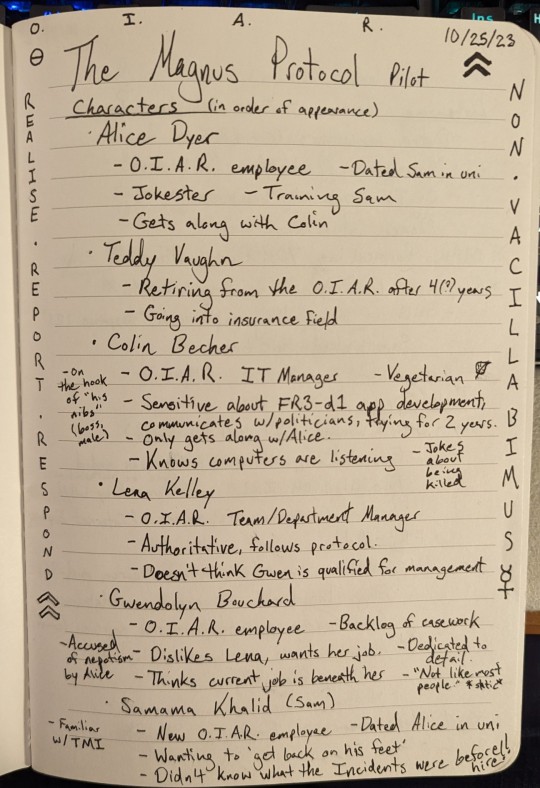
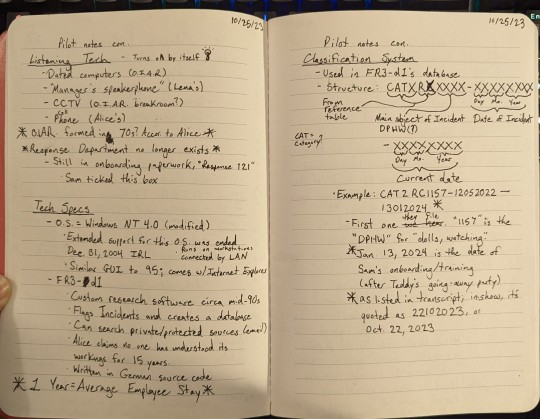
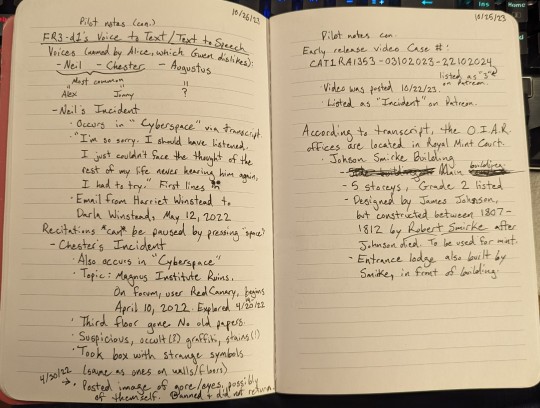
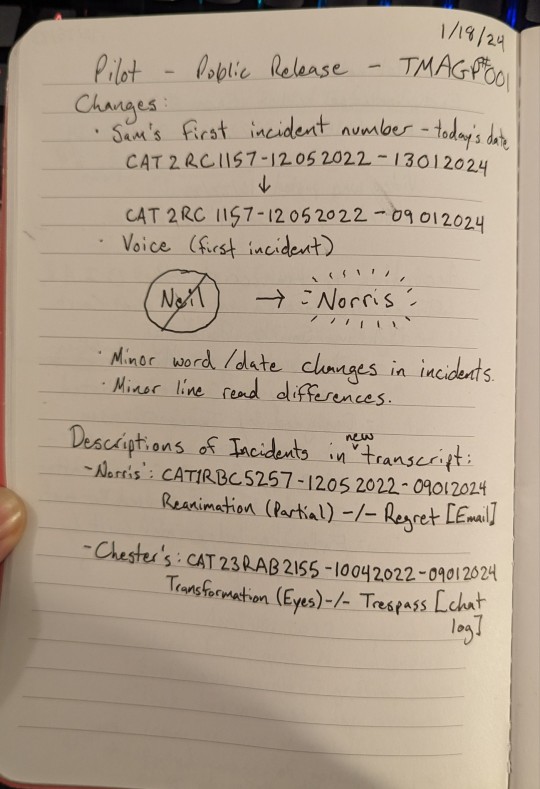
God knows how relevant any of this will turn out to be, but I'm nothing if not a collector of trivial information
Very long text beneath the cut:
Page 1
The Magnus Protocol Pilot 10/25/23
Characters (in order of appearance)
Alice Dyer -O.I.A.R. employee -Dated Sam in uni -Jokester -Training Sam -Gets along with Colin
Teddy Vaughn -Retiring from the O.I.A.R. after 4 (?) years -Going into insurance field
Colin Becher -O.I.A.R. IT Manager -Vegetarian 🥬 -On the hook of "his nibs" (boss, male) -Sensitive about FR3-d1 app development, communicates w/politicians, trying for 2 years -Only gets along w/Alice -Knows computers are listening -Jokes about being killed
Lena Kelley -O.I.A.R. Team/Department Manager -Authoritative, follows protocol -Doesn't think Gwen is qualified for management
Gwendolyn Bouchard -O.I.A.R. employee -Backlog of casework -Dislikes Lena, wants her job -Dedicated to detail -Accused of nepotism by Alice -Thinks current job is beneath her -"Not like most people." *static*
Samama Khalid (Sam) -New O.I.A.R. employee -Dated Alice in uni -Wanting to 'get back on his feet' -Familiar with TMI -Didn't know what the Incidents were before hire!!
Page 2
Pilot notes con. 10/25/23
Listening Tech - Turns on by itself 💡
Dated computers (O.I.A.R.)
"Manager's speakerphone" (Lena's)
CCTV (O.I.A.R. breakroom?)
Cell phone (Alice's)
*O.I.A.R. formed in 70s? Accor. to Alice*
*Response Department no longer exists*
Still in onboarding paperwork, "Response 121"
Sam ticked this box
Tech Specs
O.S. = Windows NT 4.0 (modified) -Extended support for this O.S. was ended Dec. 31, 2004 IRL -Runs on workstations connected by LAN -Similar GUI to 95; comes w/Internet Explorer
FR3-d1 -Custom research software circa mid-90s -Flags Incidents and creates a database -Can search private/protected sources (email) -Alice claims no one has understood its workings for 15 years -Written in German source code
*1 Year = Average Employee Stay*
Page 3
Pilot notes con. 10/25/23
Classification System
Used in FR3-d1's database
Structure: CATXRXXXXX-XXXXXXXX-XXXXXXXX
CATXRX -> From reference table (CAT = Category?) First four digits -> Main subject of Incident DPHW (?) Next eight digits -> Date of Incident Last eight digits -> Current date
Example: CAT2RC1157-12052022-13012024* -First one we hear they file. "1157" is the "DPHW" for "dolls, watching."
*Jan. 13, 2024 is the date of Sam's onboarding/training (after Teddy's going-away party)
*as listed in transcript; in-show, it's quoted as 22102023, or Oct. 22, 2023
Page 4
Pilot notes (con.) 10/25/23
FR3-d1's Voice to Text/Text to Speech
Voices (named by Alice, which Gwen dislikes):
Neil = Alex
Chester = Jonny
(those two most common)
Augustus = ?
Neil's Incident
Occurs in "Cyberspace" via the transcript
"I'm so sorry. I should have listened. I just couldn't face the thought of the rest of my life never hearing him again, I had to try." First lines 😢
Email from Harriet Winstead to Darla Winstead, May 12, 2022
Recitations *can* be paused by pressing "space"!
Chester's Incident
Also occurs in "Cyberspace"
Topic: Magnus Institute Ruins.
On forum, user RedCanary, begins April 10, 2022. Explored 4/19-20/22.
Third floor gone. No old papers.
Suspicious, occult (?) graffiti, stains (!)
Took box with strange symbols (same as ones on walls/floors)
4/30/22 Posted image of gore/eyes, possibly of themself. Banned + did not return.
Page 5
Pilot notes con. 10/25/23
Early release video Case #: CAT1RA1353-03102023-22102024(listed as 202"3" on Patreon)
Video was posted 10/22/23.
Listed as "Incident" on Patreon.
According to transcript, the O.I.A.R. offices are located in Royal Mint Court.
Johson (sic) Smirke Building
Main building.
5 storeys, Grade 2 listed.
Designed by James Johnson, but constructed between 1807-1812 by Robert Smirke after Johnson died. To be used for mint.
Entrance lodge also built by Smirke, in front of building.
Page 6
Pilot - Public Release -TMAGP#001
Changes:
Sam's first incident number - today's date
CAT2RC1157-12052022-13012024 -> CAT2RC1157-12052022-09012024
Voice (first incident)
Neil -> *Norris*
Minor word/date changes in incidents.
Minor line read differences.
Descriptions of Incidents in new transcript:
Norris': CAT1RBC5257-12052022-09012024 Reanimation (Partial) -/- Regret [Email]
Chester's: CAT23RAB2155-10042022-09012024 Transformation (Eyes) -/- Trespass [chat log]
#will add alt text shortly#also keep in mind a lot of this was written back in October - see the last page for recent changes#tmagp#the magnus protocol#tmagp spoilers#im super stoked to have figured out the royal mint court thing
20 notes
·
View notes
Text
okay, so- the past three days have been pretty insane, hence no to-do lists. did not know hour-to-hour what in the hell i'd have to do next.
monday morning, there was a company meeting, and it was announced that we were being sold. this was not... the most surprising thing in the world, because about a month ago there was this sudden hasty push by the top to reorganize the business into distinct independent units that didn't depend on shared services. like, what else would the point of doing that be, if not to sell off pieces of the business? sure, they said that wasn't happening, but who the hell was fooled by that?
so i used to do most of my work on these projects for this one specific business unit, building and running a bunch of middleware API integrations for our learning management system. but my boss, who used to be in charge of the dev team generally, got assigned to this totally different unit- and she liked me enough that she pushed really hard to get me reassigned to her unit.
so i was already conflicted about that:
i really like my boss- she's really understanding of my need for flexibility to work on my side projects, she only cares that i get the work done (and even with many side projects, i still consistently exceed expectations and get a full-time workload done ahead of schedule), and she was pushing hard to get me a raise against upper management who'd taken to using covid austerity as an excuse to never give anyone any raises ever. and the team assigned to this unit didn't have any senior devs who could handle a big infrastructure transition, and i'd just become AWS certified, and without someone like me, my coworkers assigned to that unit would be in some hot water. plus, after the transition, maintaining a reduced suite of products would probably be easier day-to-day.
but on the other hand, all my projects in the other business unit, with the LMS- those are pretty vital, and the nature of the contracts with those clients necessitates frequent maintenance and changes. my code for those integrations is bad, for various reasons but mainly that there is no dev environment for testing changes. it's fundamentally about managing production data in databases we don't directly control, so every change has to be done very quickly and carefully, with no room for big refactors to clean things up (and risk breaking stuff). it's a mess, and no one in the other business unit is prepared to take it over. plus- i liked working directly with clients, doing work where if i did the work someone was appreciative of the work. it was motivating!
ultimately, i decided to trust my boss and follow her to the other business unit. we weren't completely splitting from the rest of the business- i'd still be able to train up someone else to take over my projects, we'd still have the shared customer accounts management software, and- crucially- i'd still have the boss who understood my needs and had no interest in squeezing value out of me.
so i went on vacation for a couple weeks right after committing to that decision- and then i came back on monday, and that day they announce we're being sold.

also that my boss is fired and being replaced by someone from the new company.

also that we have two months to completely disconnect all our products from shared service infrastructure and rebuild our own.

also no takesies-backsies, the acquisition agreement included terms that the former company not hire back any of the sold-off employees or even discuss the acquisition with them at all. no chance to react to the new information except to sign the new offer letter by close of business on Wednesday.

i was unhappy about this! can you tell???
so my first thought was- okay, this is bullshit. i still want to work for the LMS people, the LMS people still want me to work for them, there has to be a solve here. so i go to the guy in charge of that division, who also wants me to keep working there, and he says okay i'll have our lawyers look into it.
and then... he gets back to me sounding like a robot, "i am unable to discuss this further with you at this time", which is so obviously out of character for the guy that i can tell legal's thrown the book at him. i talk to legal myself- it's a dead end. they can't- they're unable to even talk about why they can't talk about it, because obviously this deal was engineered to prevent me from doing exactly what i'm trying to do here.
so i go at it from the other angle. president of the sold company, now a wholly-owned for-profit subsidiary of a nonprofit organization (is that even allowed???), i explain to him, hey, this is a mistake, i'm only here because my old boss really wanted me to be on her team, surely you can let me go continue doing my actual job?
nope.

so then i start playing hardball.
the salary they're offering me is, adjusted for inflation, less than the salary i was offered two years ago, which had come with the (entirely failed) non-promise that i'd be bumped up to a certain level very quickly after some formalities re: the employment structure. i explain, in detail, how upset i am with the entire state of affairs- and i threaten to walk, which i am allowed to do. i'm not required to sign their new contract- i'd need to go job-hunting, sure, but i have money in the bank, i can afford to do it, and i could definitely get a better deal somewhere else.
this is a tense situation! my old boss knew this team needed me- but they unceremoniously fired her while she was on vacation, so her opinion doesn't mean dirt to them apparently. it's unclear how vital i really am to this- they could maybe train up one of the other devs to handle the AWS stuff.
and on my side- if i walk, that's it. all that horrible messy code for the LMS stuff- i don't get two months to train someone else up and write documentation and do some housecleaning. i'm gone! my horrific dirty laundry (and hours and hours of regular maintenance work) gets handed off to some other dev who's totally unprepared for it, and that person inevitably puts a curse on my entire family line as retribution for me leaving them holding that intolerable bag. i don't actually want to walk, because then i end up the bad guy in the eyes of people i respect and care about.
(also i'd have to do a job hunt and that shit is so god damn annoying you have no idea you probably have some idea.)
so i tell the guy, look- i can do better. i'm basically starting over doing harder work at an unfamiliar company, and if i'm doing that anyway, why not do it for someone who'll pay me? if you don't give me X amount of money, i'm walking out, and now you don't have an infrastructure guy during the two-month window you have to migrate a shit-ton of infrastructure. i am a serious dude and you can't just fuck with me!
(and inside i'm like:

because oh god i am not a serious dude i am so easily fucked with what if i'm pushing my luck too hard)
and he lets me fuckin' stew. 5:00 on wednesday i need to have either signed a contract or not signed a contract, and he hedges and goes to talk with the higher-ups and makes no promises, and i have no idea whether it's because i scared him or if he's trying to work out how to replace me or what. all this negotiation has been eating my brain for the past couple days and it's coming down to the wire-
and then a couple hours before the deadline he gets back to me with a counteroffer. it's less than i was asking, because that's how negotiations work, but it is more than i was making when i was brought on, by a good 10k.

so now it's on to round two. i'm gonna stick around for this two-month period, make this transition work, clean up my mess and take care of things with my now ex-coworkers- and then if they haven't either proven their management is tolerable or given me a crystal-clear path to advancement, we're back to the standoff- except this time, they'll have a good idea of exactly what it is they stand to lose.
haaaaaaaaaaaaaaah. okay. okay. yeah. so that's dealt with for the time being. i can breathe now. we'll see how it goes. fuck.
27 notes
·
View notes
Text
Biometric Attendance Machine

A biometric attendance machine is a technology used to track and manage employee attendance based on biometric data, such as fingerprints, facial recognition, or iris scans. These systems are often employed in workplaces, educational institutions, and other organizations to ensure accurate and secure tracking of time and attendance. Here’s a comprehensive overview of biometric attendance machines:
Types of Biometric Attendance Machines
Fingerprint Scanners
Description: Use fingerprint recognition to verify identity. Employees place their finger on a sensor, and the system matches the fingerprint against a stored template.
Pros: Quick and reliable; well-suited for high-traffic areas.
Cons: May be less effective with dirty or damaged fingers; requires regular cleaning.
Facial Recognition Systems
Description: Use facial recognition technology to identify individuals based on their facial features. Employees look into a camera, and the system matches their face against a database.
Pros: Contactless and convenient; can be integrated with other security measures.
Cons: May be affected by changes in lighting or facial features; requires good camera quality.
Iris Scanners
Description: Scan the unique patterns in the iris of the eye to identify individuals. Employees look into a device that captures the iris pattern.
Pros: Highly accurate; difficult to spoof.
Cons: Typically more expensive; requires careful alignment.
Voice Recognition Systems
Description: Use voice patterns for identification. Employees speak into a microphone, and the system analyzes their voice.
Pros: Contactless; can be used in various environments.
Cons: Can be affected by background noise or voice changes.
Hand Geometry Systems
Description: Measure the shape and size of the hand and fingers. Employees place their hand on a scanner, which records its dimensions.
Pros: Effective and reliable; less invasive.
Cons: Requires specific hand placement; less common than fingerprint or facial recognition systems.
Key Features
Data Storage and Management
Centralized Database: Stores biometric data and attendance records securely.
Integration: Often integrates with HR and payroll systems to streamline data management.
Accuracy and Speed
High Accuracy: Minimizes errors and false positives/negatives in identification.
Fast Processing: Ensures quick check-in and check-out times for employees.
Security
Data Encryption: Protects biometric data with encryption to prevent unauthorized access.
Anti-Spoofing: Includes features to detect and prevent fraudulent attempts, such as using fake fingerprints or photos.
User Interface
Ease of Use: Features a simple interface for both employees and administrators.
Reporting: Generates detailed reports on attendance, overtime, and absences.
Customization
Settings: Allows customization of attendance policies, work schedules, and shift timings.
Alerts and Notifications: Sends alerts for exceptions or anomalies, such as missed clock-ins or outs.
Benefits
Improved Accuracy: Reduces errors and fraud associated with manual or card-based systems.
Enhanced Security: Ensures that only authorized personnel can access facilities and clock in/out.
Time Efficiency: Speeds up the check-in and check-out process, reducing queues and wait times.
Automated Tracking: Automates attendance management, reducing administrative workload.
Detailed Reporting: Provides comprehensive data on attendance patterns, helping with workforce management and planning.
Considerations
Privacy Concerns: Ensure compliance with privacy laws and regulations regarding biometric data collection and storage.
Cost: Evaluate the initial investment and ongoing maintenance costs. High-end biometric systems may be more expensive.
Integration: Consider how well the system integrates with existing HR and payroll software.
User Acceptance: Provide training to employees and address any concerns about the use of biometric technology.
Popular Brands and Models
ZKTeco: Known for a wide range of biometric solutions, including fingerprint and facial recognition systems.
Hikvision: Offers advanced facial recognition systems with integrated attendance management.
Suprema: Provides high-quality fingerprint and facial recognition devices.
BioTime: Specializes in biometric attendance systems with robust reporting and integration features.
Anviz: Offers various biometric solutions, including fingerprint and facial recognition devices.
By choosing the right biometric attendance machine and properly implementing it, organizations can improve attendance tracking, enhance security, and streamline HR processes.
2 notes
·
View notes
Text
The Evolution and Impact of ERP Software in the UAE: A Comprehensive Analysis
ERP stands for Enterprise Resource Planning. It is a type of software system that integrates and manages core business processes and functions within an organization. ERP software typically provides a centralized database and a suite of applications that automate and streamline business activities across various departments such as finance, human resources, supply chain management, manufacturing, sales, and customer service.
In the fast-paced landscape of business operations, efficient management of resources and information is critical for success. Enterprises in the United Arab Emirates (UAE) have witnessed a remarkable transformation in their operational efficiency and competitiveness through the adoption of Enterprise Resource Planning (ERP) software. This article delves into the evolution, benefits, challenges, and future trends of ERP software within the UAE context.
In recent decades, Enterprise Resource Planning (ERP) software has played a transformative role in how businesses in the United Arab Emirates (UAE) operate and manage their resources. This article delves into the evolution, adoption, and impact of ERP systems within the UAE's business landscape. By exploring the unique challenges and opportunities presented by the UAE's dynamic economy, we can better understand how ERP software has become an indispensable tool for organizations seeking efficiency, integration, and scalability.
Evolution of ERP Software
The adoption of ERP software in the UAE mirrors global trends but is uniquely shaped by regional business requirements and technological advancements. In the early 2000s, ERP systems gained traction among larger corporations seeking to streamline their complex processes. Major multinational ERP providers like SAP, Oracle, and Microsoft Dynamics established a strong presence in the region, catering to diverse industry needs including finance, manufacturing, retail, and logistics.
A notable development in recent times is the movement towards cloud-centric ERP solutions.This transition offers scalability, flexibility, and cost-effectiveness, allowing businesses in the UAE to manage their operations more efficiently. Local ERP vendors have also emerged, offering tailored solutions that cater specifically to the nuances of the UAE market, such as compliance with local regulations and cultural practices.
Challenges and Obstacles
Despite the numerous benefits, ERP implementation in the UAE is not devoid of challenges. One prominent obstacle is the high initial investment required for ERP deployment, including software licensing, customization, and training costs. For smaller businesses, this financial commitment can be prohibitive, leading to slower adoption rates among SMEs.
Cultural factors and change management also pose challenges. Embracing new technology often requires a shift in organizational culture and employee mindsets. Resistance to change, coupled with the need for extensive training, can hinder the successful implementation of ERP systems in the UAE.
Furthermore, data security and privacy concerns are paramount, especially in light of stringent regulatory frameworks such as the UAE's Data Protection Law. Ensuring compliance with local data protection regulations adds complexity to ERP deployment, necessitating robust cybersecurity measures and data governance protocols.
The Business Landscape of the UAE
The UAE is renowned for its vibrant economy, diversified industries, and strategic geographical location. Over the years, the country has emerged as a global business hub attracting multinational corporations, SMEs, and startups alike. Key sectors such as finance, real estate, construction, logistics, tourism, and manufacturing contribute significantly to the nation's GDP. However, this diversification has also brought complexities in managing business operations efficiently.
The Emergence of ERP Solutions
As businesses in the UAE expanded and diversified, traditional methods of managing operations became inadequate. The need for integrated systems that could streamline processes across departments led to the rise of ERP solutions. Initially developed to manage manufacturing processes, ERP systems evolved to encompass finance, human resources, supply chain, customer relationship management, and more. This evolution mirrored the growth and diversification of UAE businesses.
Factors Driving ERP Adoption
Several factors have fueled the adoption of ERP software among businesses in the UAE:
Global Competition: The UAE's aspiration to compete on a global scale necessitated advanced operational efficiencies that ERP systems could deliver.
Regulatory Compliance: The UAE's regulatory environment, including VAT implementation, required robust financial and reporting capabilities that ERP systems could provide.
Scalability: With rapid economic growth, businesses needed scalable solutions to manage increasing complexities.
Integration Needs: As businesses diversified, the need for seamless integration across functions became crucial.
Challenges in ERP Implementation
While the benefits of ERP systems are substantial, implementing them poses challenges:
Cultural Factors: Embracing technological change and adopting new systems can face resistance due to cultural factors.
Resource Constraints: SMEs may struggle with the limited resources required for ERP implementation and customization.
Data Security and Privacy: The UAE's focus on data security and privacy necessitates robust ERP solutions compliant with local regulations.
Impact of ERP on UAE Businesses
The impact of ERP software on businesses in the UAE has been profound:
Improved Efficiency: Streamlined processes lead to increased productivity and reduced operational costs.
Enhanced Decision Making: Real-time data availability empowers businesses to make informed decisions.
Better Customer Experience: Integrated systems ensure seamless customer interactions and improved service delivery.
Regulatory Compliance: ERP systems aid in meeting regulatory requirements efficiently.
Key ERP Players in the UAE
Several global and regional ERP providers cater to the UAE market, offering tailored solutions to meet local business needs. Major players include SAP, Oracle, Microsoft Dynamics, Sage, and Epicor, among others.
Future Trends and Innovations
Looking ahead, several trends are poised to shape the future of ERP software in the UAE. Artificial Intelligence (AI) and Machine Learning (ML) are increasingly integrated into ERP systems, enabling predictive analytics and automation of routine tasks. This enhances decision-making capabilities and further optimizes business processes.
Mobile ERP applications are also gaining popularity, allowing stakeholders to access critical business data on the go. The rise of Industry 4.0 and the Internet of Things (IoT) is driving demand for ERP solutions that can seamlessly integrate with smart devices and sensors, enabling real-time monitoring and control of operations.
Moreover, the convergence of ERP with other technologies like blockchain promises enhanced transparency and security in supply chain management, crucial for industries like healthcare and finance.
Conclusion
In conclusion, ERP software has become an integral component of the UAE's business ecosystem, driving efficiency, integration, and growth across diverse sectors. While challenges exist, the transformative impact of ERP systems on businesses in the UAE underscores their importance in navigating complex operational landscapes. As technology continues to evolve, so too will the role of ERP in shaping the future of business in the UAE.ERP software has emerged as a transformative tool for businesses in the UAE, driving efficiency, innovation, and competitiveness across industries. Despite challenges such as high costs and cultural adaptation, the benefits of ERP implementation are substantial, ranging from streamlined operations to improved customer satisfaction. Looking ahead, the evolution of ERP software in the UAE is poised to align with global technological advancements, incorporating AI, IoT, and blockchain to unlock new possibilities for business growth and development. As enterprises continue to navigate the digital landscape, ERP remains a cornerstone of strategic management, enabling organizations to thrive in an increasingly complex and dynamic marketplace.
In summary, ERP software has been a game-changer for businesses in the UAE, enabling them to streamline operations, enhance decision-making, and adapt to a rapidly evolving marketplace. As the UAE continues to position itself as a global economic powerhouse, the role of ERP systems will remain pivotal in supporting the growth and sustainability of businesses across various sectors.
2 notes
·
View notes
Text
How Important is CRM Integrations and Customizations?
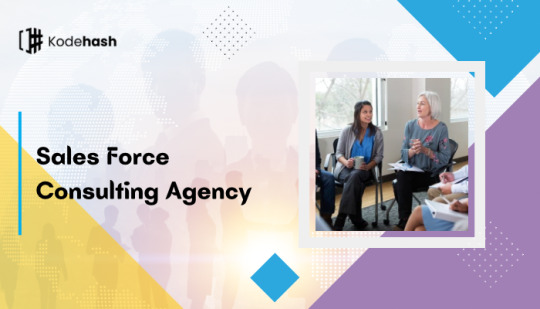
In this digital era, businesses worldwide give importance to customer relationship software as satisfied customers are the backbone of a successful business. The businesses using Custom CRM Integration can boost their productivity manifolds. CRM Integrations And Customizations is the process to connect a CRM system with other software applications or systems and tailoring the CRM system as per the business’ specific needs.
CRM Integration?
CRM integration means seamlessly connecting CRM software with third-party applications, business tools, platforms, or databases. This integration ensures that relevant information from different systems is available within the CRM, so that the businesses can get a holistic view of customer data.
CRM Customizations
CRM customizations means tailoring the CRM system to match specific business workflows, processes, or requirements. Customizations include Custom Data Fields, Workflow Automation, User Interface (UI) Customization, and Reporting and Dashboards:
How CRM Integrations and Customizations Helps Strengthen Your Business?
CRM integrations and customizations are essential to maximise the effectiveness of a CRM system and drive. CRM Integrations ensure seamless data flow and synchronisation between the CRM system and other key business systems. By integrating the CRM with other platforms like marketing automation, customer support, etc. businesses can get a complete view of the customer data. An effective CRM system is a win-win solution and a smart integration improves employee productivity, as well as customer experience.
Advantages of Having Customised CRM Integration
It’s Easy to Use
A customised CRM software helps manage multiple processes simultaneously. The custom CRM is designed keeping in mind the issues faced by employees and thus it comes with many valuable features.
Custom-made Features
A CRM system has several in-built features that helps manage complex tasks with ease. With a customised CRM, the businesses have the much needed features without any unnecessary hassles and bustles. CRM integration is designed to smartly manage the workflow and help employees stay more productive.
Better Insights and Higher Revenue
With Custom CRM integration, you can filter and synthesise data exactly the way you want and get the tedious task achieved within a fraction of seconds. The businesses get quick access to real-time insights that help drive your business fast, lower the risks, and explore untapped areas in business.
Conclusion
CRM integrations and customizations are important to optimise the CRM system for specific business needs, streamline operations, improve productivity & data accuracy, and offer a tailored experience to users. These adaptations make the CRM system a more powerful tool and easily aligns with the unique requirements and goals of the business.
By leveraging the power of a customised and integrated CRM System, all size businesses can drive growth, improve customer relationships, and achieve long-term success.
So this time give your sales team a flexible and customised solution that simplifies your task exactly the way you want. If you want to know more about the professional CRM Integrations and Customizations services, feel free to contact Kodehash now.SOURCE URL: https://medium.com/@kodehash8/how-important-is-crm-integrations-and-customizations-12d203a64bb2
2 notes
·
View notes
Text
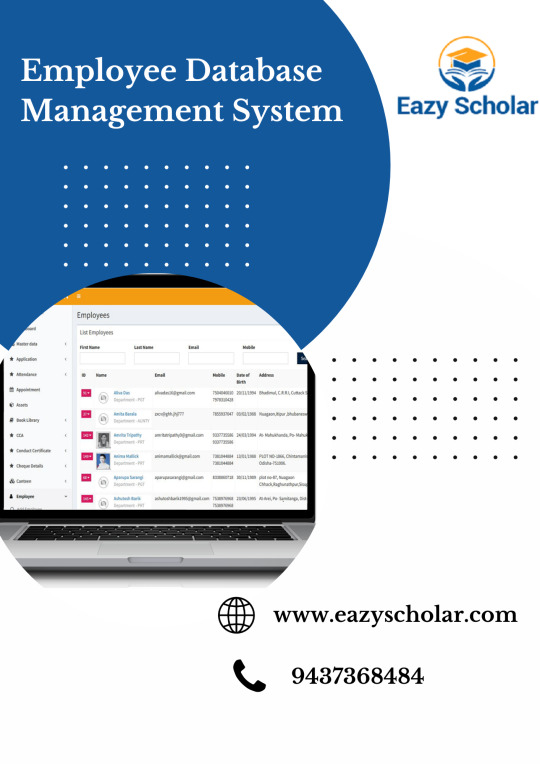
Employee Database Management System
An Employee Database Management System is a software tool that efficiently stores, organizes, and manages employee information within an organization. It enables HR professionals to securely maintain records of employees, including personal details, employment history, salary data, and performance evaluations. This system streamlines HR tasks and ensures data accuracy.
#Employee Database Management System#best employee management software#Employee Management Software#employee management system
0 notes
Text
Streamlining Operations: Exploring the Best Employee Management Software Solutions
In the ever-evolving landscape of business operations, the significance of efficient employee management cannot be overstated. As organizations grow and adapt, the need for robust and versatile employee management software becomes increasingly essential. Such software not only aids in organizing HR tasks but also enhances productivity, streamlines processes, and fosters a positive work culture.
Amidst the plethora of options available, several standout employee management software solutions have gained acclaim for their comprehensive features, user-friendly interfaces, and ability to address diverse organizational needs. Let's delve into some of the top contenders in this field:
BambooHR: Renowned for its simplicity and functionality, BambooHR is a user-friendly HR software designed for small to medium-sized businesses. It offers a comprehensive suite of tools for HR tasks, including applicant tracking, onboarding, performance management, and time-off tracking. The intuitive interface and customizable dashboards make it a favored choice for HR professionals seeking a seamless experience.
Zenefits: Recognized for its all-in-one HR platform, Zenefits offers solutions for HR, payroll, benefits, time tracking, and compliance. Its user-friendly interface simplifies complex HR processes, allowing businesses to manage their workforce efficiently. Zenefits' integration capabilities with various third-party applications make it adaptable to diverse business needs.
Workday: Ideal for larger enterprises, Workday is a cloud-based HR and finance management software known for its robust functionalities. It encompasses HR planning, talent management, payroll, and analytics. Workday's strength lies in its ability to handle complex organizational structures while providing real-time insights for strategic decision-making.
ADP Workforce Now: Catering to businesses of all sizes, ADP Workforce Now offers a comprehensive suite of HR solutions covering payroll, talent management, time and attendance tracking, and benefits administration. Its scalability and customizable features make it suitable for organizations experiencing growth or change.
Gusto: Gusto stands out for its user-friendly payroll and HR software designed primarily for small businesses. It streamlines payroll processes, benefits administration, and compliance, simplifying administrative tasks and enabling businesses to focus on growth and employee engagement.
Paychex Flex: Tailored for midsize to large enterprises, Paychex Flex provides a suite of HR and payroll solutions. It offers features such as time and attendance tracking, benefits administration, and employee self-service tools. Its scalability and robust reporting capabilities make it an attractive choice for growing organizations.
SAP SuccessFactors: As part of the SAP suite, SuccessFactors is an enterprise-level HR software that offers comprehensive talent management solutions. It covers performance management, learning and development, recruiting, and workforce analytics. Its integration with other SAP modules provides a holistic approach to HR management within large organizations.
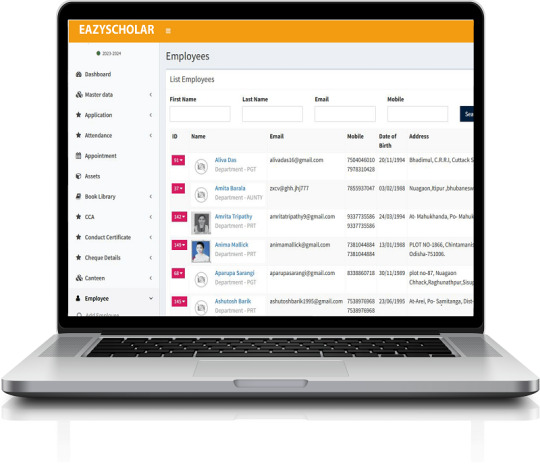
Kronos Workforce Ready: Kronos offers Workforce Ready, a unified HR, payroll, and talent management solution designed for businesses of all sizes. Its cloud-based platform provides functionalities for timekeeping, scheduling, HR administration, and compliance, making it an efficient choice for managing a diverse workforce.
In selecting the best employee management software for a particular organization, several factors must be considered:
Scalability: The software should be scalable to accommodate the organization's growth without compromising performance or functionality.
Usability: An intuitive interface and user-friendly features are crucial for widespread adoption and smooth integration into existing workflows.
Integration Capabilities: Compatibility with other systems and applications is vital for seamless data flow and efficient operations.
Customization: The ability to tailor the software to meet specific business needs ensures optimal utilization and efficiency.
Data Security and Compliance: Robust security measures and adherence to industry regulations are paramount to protect sensitive HR information.
Moreover, it's essential to assess the software's support and training resources to ensure a smooth implementation process and ongoing assistance.
In conclusion, the choice of employee management software greatly influences an organization's HR operations and overall efficiency. Each software solution mentioned offers unique strengths catering to different organizational sizes and requirements. Careful evaluation and consideration of these factors are imperative in selecting the best-suited software to optimize employee management and drive business success.
0 notes
Text
Streamlining Your Operations: How Software Solutions Can Boost Business Efficiency
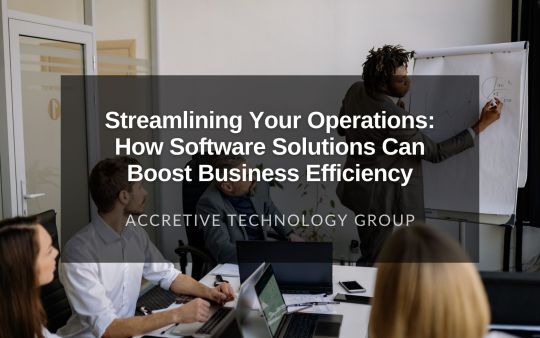
Improving efficiency is crucial for companies to stay competitive and achieve success. One way businesses can enhance their efficiency is by leveraging software solutions. Specifically, project management software, accounting and financial management software, customer relationship management (CRM) software, and human resources management (HRM) software are instrumental in streamlining operations. In this blog post, we will explore how these software solutions can help businesses improve their efficiency and drive success.
Project Management Software:
Efficient project management is crucial for completing tasks on time and within budget. Project management software offers a centralized platform for planning, scheduling, and collaboration. It allows businesses to break down projects into tasks, assign responsibilities, and track progress in real-time. By providing visibility into project timelines and resource allocation, businesses can optimize workflows, identify bottlenecks, and allocate resources effectively. Moreover, features like task dependencies, document sharing, and automated notifications enhance communication and collaboration, minimizing delays and ensuring smooth project execution.
Accounting and Financial Management Software:
Financial management is the backbone of any business. Accounting and financial management software streamline financial processes, such as invoicing, expense tracking, and budgeting. Automating these tasks minimizes human error, saves time, and improves accuracy. Additionally, these software solutions provide real-time insights into financial data, enabling businesses to make informed decisions promptly. With features like automated report generation, tax compliance, and integration with banking systems, businesses can optimize financial operations, reduce costs, and improve cash flow management.
Customer Relationship Management (CRM) Software:
Customers are the lifeblood of any business, making CRM software essential for efficient customer management. CRM software consolidates customer data, interactions, and communication history in a centralized database. This enables businesses to gain a comprehensive view of their customers, personalize interactions, and provide better customer service. By automating lead management, sales tracking, and customer support processes, businesses can streamline their operations, enhance customer satisfaction, and increase sales. Moreover, CRM software offers analytical tools to identify customer trends, preferences, and behavior, enabling businesses to tailor their strategies accordingly.
Human Resources Management (HRM) Software:
Efficiently managing human resources is crucial for organizational success. HRM software simplifies and automates various HR processes, including recruitment, employee onboarding, payroll, and performance management. By centralizing employee data, businesses can streamline administrative tasks, reduce paperwork, and enhance data accuracy. Additionally, HRM software offers self-service portals for employees, empowering them to access and update their information, request time off, and participate in performance evaluations. These features improve employee satisfaction, increase productivity, and enable HR teams to focus on strategic initiatives.
Leveraging software solutions is essential for businesses aiming to streamline their operations and boost efficiency. Project management software optimizes project execution, accounting and financial management software enhances financial processes, CRM software improves customer management, and HRM software streamlines HR operations. By adopting these software solutions, businesses can automate repetitive tasks, improve collaboration, gain real-time insights, and allocate resources effectively. Embracing software solutions not only saves time and reduces costs but also empowers businesses to focus on innovation and growth, ultimately driving long-term success.
2 notes
·
View notes
Text
One of the largest federations of unions and several former officials of the US Occupational Safety and Health Administration have raised concerns about the possibility that Elon Musk and the so-called Department of Government Efficiency could potentially gain access to sensitive information shared with OSHA and the Department of Labor by whistleblowers at the centibillionaire’s companies.
While Musk serves as a “special government employee” in the Trump administration, SpaceX, Tesla, and The Boring Company are the subject of more than 50 ongoing workplace health and safety cases opened by OSHA in the past five years, according to a public database maintained by the agency. OSHA sits within the Department of Labor, where DOGE operatives have been working since at least March 18.
In a memo shared exclusively with WIRED, the American Federation of Labor and Congress of Industrial Organizations (AFL-CIO), which is currently suing the Trump administration over DOGE’s access to records at the Department of Labor, says they believe that the news reports and OSHA cases in its memo allegedly illustrate “gross mistreatment and even abuse of workers” at Musk companies in five different states. In the memo, the union federation alleges that as Musk attempts to exert “unilateral control” over the federal government through DOGE, “his record as a boss should be of concern to every worker in America.”
Musk, Tesla, SpaceX, The Boring Company, OSHA, and the Department of Labor did not respond to requests for comment.
There’s currently no public evidence to suggest that Musk or DOGE has accessed confidential files at OSHA. But the fact that DOGE has tried to seek access to other potentially sensitive databases at the Department of Labor and a number of other federal agencies worries both the AFL-CIO and former OSHA administrators.
Jordan Barab, former deputy assistant secretary of OSHA under President Barack Obama, tells WIRED that “no company who is being cited by OSHA or investigated by OSHA” should obtain the ability to access the agency’s “internal and confidential files.”
In a March 29 court filing, lawyers representing the Trump administration in the AFL-CIO’s lawsuit said that DOGE operative Marko Elez currently has read access to four record systems at the Department of Labor, including a database for managing employee access to federal buildings and systems, and another for keeping track of unemployment benefit claims. The filing states that Elez “has not accessed any of the systems,” but has installed Python and a tool for editing software code at the agency.
Tesla is currently the subject of one active OSHA investigation, according to the public database, meaning OSHA has yet to issue a citation or dismiss the case. The case was opened last month in response to an unspecified “safety” complaint about a Tesla facility in Lathrop, California.
Since April 2020, OSHA has issued 46 citations to Tesla—for a variety of allegations, including claims of violating OSHA safety regulations, failing workplace inspections, or because a worker was injured at the facility—more than half of which Tesla is currently disputing. During that same time period, OSHA had six investigations that resulted in citations to SpaceX and three to the Boring Company, a tunnel construction company founded by Musk.
In the memo, the AFL-CIO highlights some two dozen accidents and alleged safety issues reported at Tesla, SpaceX, and The Boring Company since 2016 as the basis for its concern, some of which were the subject of recent OSHA investigations. In one incident reported to OSHA last year, a licensed electrician named Victor Joe Gomez Sr. was electrocuted and killed after being instructed to inspect electrical panels at Tesla’s Gigafactory in Austin, Texas, that OSHA determined had not been properly disconnected beforehand. (The case remains open, as Tesla is actively disputing it.)
Two separate OSHA citations at other Tesla factories involved fingertip amputations. At a SpaceX facility in 2022, an employee “suffered a skull fracture and head trauma and was hospitalized in a coma for months,” according to the final OSHA accident report, after experiencing what the agency described as a technical problem with a newly automated piece of machinery. SpaceX did not contest its OSHA citation and $18,475 fine.
Liz Shuler, the president of AFL-CIO, claims that a number of Tesla workers have repeatedly alleged to the federation that safety isn’t prioritized at the car company. The AFL-CIO works with the United Automobile, Aerospace & Agricultural Implement Workers of America (UAW), but it does not represent employees at Tesla or SpaceX.
“There are clearly some serious safety hazards in their facilities,” Debbie Berkowitz, former chief of staff and a senior adviser at OSHA under Obama, alleges, referring to Tesla.
After OSHA issues a citation, employers have the right to challenge it, and Tesla does this often, according to the agency’s public database. Of the 46 Tesla cases in which OSHA issued citations over the past five years, the memo cites 27 that remain open because the car company is actively disputing them with the agency. Two SpaceX cases and one Boring Company case remain open for the same reason. The cases can’t be closed until both OSHA and the companies agree on the terms of the citation, which may include associated fines and specific changes the company has to make to improve worker safety.
David Michaels, the assistant secretary of labor for OSHA under Obama, tells WIRED that, in general, big companies typically don’t have a financial incentive to challenge OSHA citations, since they usually are accompanied by fines costing only a few thousand dollars. However, a company isn’t required to address the specific hazard that led to an accident until after a case is closed. In order to avoid addressing these alleged problems, Michaels says that generally, some companies may be motivated to keep cases open.
“Some employers decide they don't want to abate the hazard, they don't agree with the citation, and they will spend many, many thousands of dollars fighting the case, and it'll cost them far more than simply paying a small fine and abating the hazard,” Michaels says.
There is currently no evidence that Musk has access to any confidential databases at the Department of Labor that may contain personal information about whistleblowers. But former OSHA administrators say the agency does house records that would anonymize whistleblowers, as well as employees who participated in anonymous interviews with agency investigators.
Berkowitz says her fear is that someone with this amount of access could be able to identify every whistleblower who has contributed to an OSHA investigation into one of his companies. Michaels adds that, generally speaking, there is “a very significant concern” that whistleblowers who have their identities revealed would be subject to retaliation or intimidation.
“If those were released to the employer, workers could suffer retaliation, and while that retaliation is absolutely forbidden by law, it's very difficult for OSHA to protect those workers,” Michaels says.
Shuler tells WIRED that whistleblowers speak out about their companies at great personal risk, and that she is extremely concerned that their anonymity and safety won’t be preserved. “It's, to me, an abomination in terms of the checks and balances that we've put in place into these systems,” Shuler says. “Knowing that our government has trust, that we've been able to get workers to trust that their government will keep them safe, and now we have an unelected billionaire basically disrupting that sense of security.”
Musk has at least twice discussed retaliating against people who leaked information in recent years. In March, Musk said that he would “look forward to the prosecutions” of Pentagon workers after information was leaked to journalists. At X, Musk threatened to sue employees who violated their nondisclosure agreements.
The future of OSHA under the Trump administration more broadly remains unclear. Rebecca Reindel, director of occupational safety and health for the AFL-CIO and a member of OSHA’s National Advisory Committee on Occupational Safety & Health since 2022, tells WIRED that the group would have normally met twice already by this point in the year, but no meetings have occurred. Her committee was working on crafting guidelines to prevent heat-related injury and illness in the workplace.
In recent weeks, DOGE has canceled the leases of seventeen OSHA area offices, according to a website where the group lists how much money it claims to have saved the federal government. Neither DOGE nor OSHA have said whether these offices will fully close, downsize, or merge with other existing area offices. At least for now, DOGE doesn’t appear to have orchestrated mass firings at OSHA the way it has at many other federal agencies. “We have not seen massive cuts yet,” Reindel says. “We are expecting them to come.”
14 notes
·
View notes
Text
Reuters Exclusive: In an authoritarian power grab, Musk aides lock government workers out of computer systems at US agency, sources say

Tim Reid at Reuters:
WASHINGTON, Jan 31 (Reuters) - Aides to Elon Musk charged with running the U.S. government human resources agency have locked career civil servants out of computer systems that contain the personal data of millions of federal employees, according to two agency officials. Since taking office 11 days ago, President Donald Trump has embarked on a massive government makeover, firing and sidelining hundreds of civil servants in his first steps toward downsizing the bureaucracy and installing more loyalists.
Musk, the billionaire Tesla (TSLA.O), opens new tab CEO and X owner tasked by Trump to slash the size of the 2.2 million-strong civilian government workforce, has moved swiftly to install allies at the agency known as the Office of Personnel Management. The two officials, who spoke to Reuters on condition of anonymity for fear of retaliation, said some senior career employees at OPM have had their access revoked to some of the department's data systems. The systems include a vast database called Enterprise Human Resources Integration, which contains dates of birth, Social Security numbers, appraisals, home addresses, pay grades and length of service of government workers, the officials said. "We have no visibility into what they are doing with the computer and data systems," one of the officials said. "That is creating great concern. There is no oversight. It creates real cybersecurity and hacking implications." Officials affected by the move can still log on and access functions such as email but can no longer see the massive datasets that cover every facet of the federal workforce. [...]
MUSK INFLUENCE
A team including current and former employees of Musk assumed command of OPM on Jan. 20, the day Trump took office. They have moved sofa beds onto the fifth floor of the agency's headquarters, which contains the director's office and can only be accessed with a security badge or a security escort, one of the OPM employees said. The sofa beds have been installed so the team can work around the clock, the employee said. Musk, a major donor to a famously demanding boss, installed beds at X for employees to enable them to work longer when in 2022 he took over the social media platform, formerly known as Twitter. "It feels like a hostile takeover," the employee said. The new appointees in charge of OPM have moved the agency's chief management officer, Katie Malague, out of her office and to a new office on a different floor, the officials said. Malague did not respond to a request for comment.
The moves by Musk's aides at OPM, and upheaval inside the Treasury building caused by other Musk aides that was reported on Friday, underscore the sweeping influence Musk is having across government. David Lebryk, the top-ranking career U.S. Treasury Department official, is set to leave his post following a clash with allies of Musk after they asked for access to payment systems, the Washington Post reported on Friday. The new team at OPM includes software engineers and Brian Bjelde, who joined Musk's SpaceX venture in 2003 as an avionics engineer before rising to become the company's vice president of human resources. Bjelde's role at OPM is that of a senior adviser. The acting head of OPM, Charles Ezell, has been sending memos to the entire government workforce since Trump took office, including Tuesday's offering federal employees the chance to quit with eight months pay. "No-one here knew that the memos were coming out. We are finding out about these memos the same time as the rest of the world," one of the officials said. Among the group that now runs OPM is Amanda Scales, a former Musk employee, who is now OPM's chief of staff. In some memos sent out on Jan. 20 and Jan. 21 by Ezell, including one directing agencies to identify federal workers on probationary periods, agency heads were asked to email Scales at her OPM email address.
Elon Musk, along with Donald Trump, are helping to destroy the US government one power trip move at a time.
#Elon Musk#Trump Administration#DOGE#Trump Administration II#Authoritarianism#Office of Personnel Management#Chuck Ezell#Amanda Scales#Musk Coup
5 notes
·
View notes